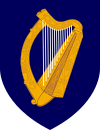
Back Gouvernement local en Irlande French Pembagian administratif Republik Irlandia ID Airijos administracinis suskirstymas Lithuanian Governo Local na República da Irlanda Portuguese جمہوریہ آئرلینڈ میں مقامی حکومت Urdu
| Local government in the Republic of Ireland | |
|---|---|
 | |
| Category | Unitary state |
| Location | Ireland |
| Number |
|
| Populations | 31,972 (County Leitrim) – 592,713 (Dublin city) |
| Areas | 54 km² (Galway city) – 7,468 km² (County Cork) |
| Government |
|
| Subdivisions | |
 |
|---|
The functions of local government in the Republic of Ireland are mostly exercised by thirty-one local authorities, termed County, City, or City and County Councils.[1][2][3] The principal decision-making body in each of the thirty-one local authorities is composed of the members of the council, elected by universal franchise in local elections every five years from multi-seat local electoral areas using the single transferable vote. Many of the authorities' statutory functions are, however, the responsibility of ministerially appointed career officials termed Chief executives.[4] The competencies of the city and county councils include planning, transport infrastructure, sanitary services, public safety (notably fire services) and the provision of public libraries.[2] Each local authority sends representatives to one of three Regional Assemblies.[5]
Local government in the state is governed by Local Government Acts 1925 to 2024, the principal act of which is the Local Government Act 2001.[6] The Local Government (Ireland) Act 1898 is the founding document of the present system.[7] The Twentieth Amendment of the Constitution of Ireland (1999) provided for constitutional recognition of local government for the first time in Ireland in a new Article 28A. The Local Government Reform Act 2014 changed the structure by the abolition of all town councils and the merger of certain county councils. The reforms came into effect in 2014, to coincide with that year's local elections.[8][9][10]
- ^ "Local Government Administration". Department of Housing, Planning and Local Government. Archived from the original on 13 November 2018. Retrieved 2 March 2019.
- ^ a b "Irish Local Government Management Agency". Archived from the original on 2 August 2021. Retrieved 2 March 2019.
- ^ "Local Government Administration". Department of Housing, Planning and Local Government. Archived from the original on 6 March 2019. Retrieved 2 March 2019.
- ^ "Irish Local Government Management Agency 2012 Board Membership". Archived from the original on 9 June 2018. Retrieved 28 April 2013.
- ^ Local Government Act 1991 (Regional Assemblies) (Establishment) Order 2014 (S.I. No. 573 of 2014), "5. (1) A regional assembly specified in column (3) of Schedule 1 shall consist of the number of members specified in column (4) of that Schedule opposite the mention in the said column (3) of that regional assembly.". Signed on 16 December 2014. Statutory Instrument of the Government of Ireland. Retrieved from Irish Statute Book on 5 March 2022.
- ^ Local Government (Mayor of Limerick) and Miscellaneous Provisions Act 2024, s. 1 (No. 7 of 2024, s. 1). Enacted on 6 March 2024. Act of the Oireachtas. Retrieved from Irish Statute Book on 9 May 2024.
- ^ Local Government (Ireland) Act 1898 (c. 37 of 1898). Enacted on 12 August 1898. Act of the UK Parliament. Retrieved from Irish Statute Book on 4 March 2021.
- ^ Telford, Lynsey (16 October 2012). "'Long overdue' reform of local Government to save €420m". Irish Independent. Archived from the original on 18 November 2012. Retrieved 16 October 2012.
- ^ "Phil Hogan says local government reform will save €420m". RTÉ News. 16 October 2012. Archived from the original on 19 December 2012. Retrieved 16 October 2012.
- ^ Carroll, Steven (16 October 2012). "Local authority plan 'to save €420m'". The Irish Times. Archived from the original on 7 November 2012. Retrieved 16 October 2012.